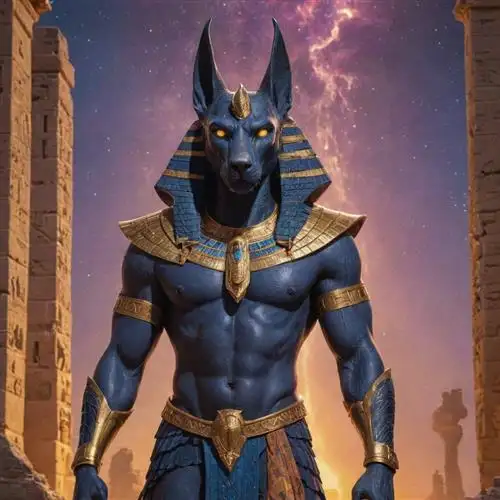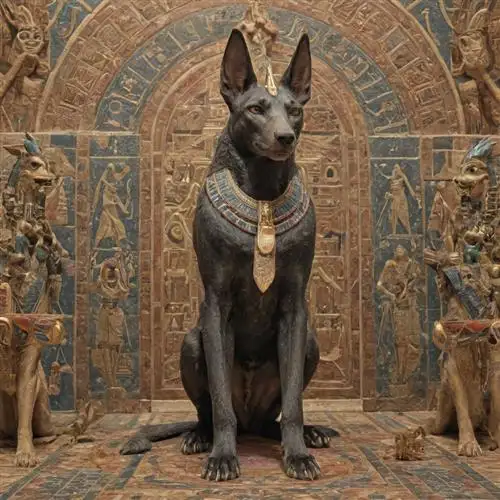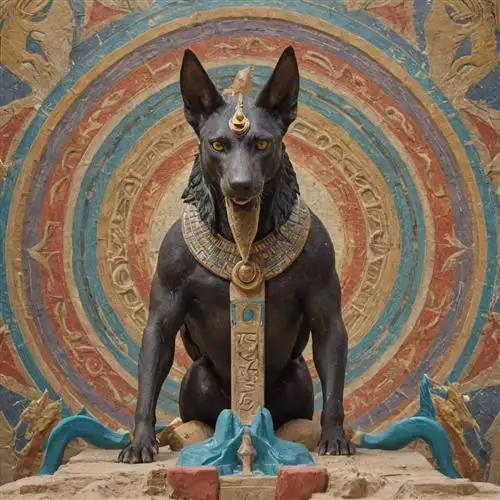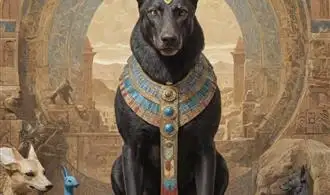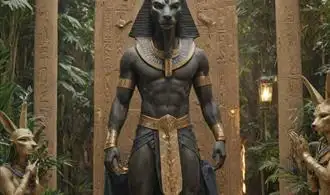
Uncovering the Mysteries of Anubis Iconography
Anubis, the ancient Egyptian god of the dead, has long captivated the imagination of scholars, historians, and individuals fascinated by the rich symbolism of ancient cultures. As a professional content writer, I'm excited to guide you through the intricate and often mysterious world of Anubis iconography, revealing insights that can deepen your appreciation and understanding of this revered deity.
Anubis' iconography is a tapestry of symbolism, woven with profound significance and complex layers of meaning. At the core of this iconography is the jackal-headed figure, a representation that speaks to Anubis' role as the guardian of the dead and the embalming process. However, the depth of Anubis' iconography extends far beyond this familiar depiction, incorporating a myriad of symbols and motifs that offer glimpses into the ancient Egyptian worldview.
One of the most captivating aspects of Anubis iconography is the symbolism associated with the jackal itself. The jackal, a creature that was revered for its cunning and adaptability, was seen as the perfect embodiment of Anubis' dual nature – both a protector of the dead and a guide to the afterlife. The jackal's keen senses and ability to navigate the boundaries between the physical and spiritual realms made it an ideal representation of Anubis' role as the intermediary between the living and the dead.
Delving deeper into Anubis iconography, we uncover a wealth of other symbols and motifs that add richness and depth to the deity's symbolism. The ankh, the ancient Egyptian symbol of life, is often depicted in Anubis iconography, signifying the god's power to grant or preserve life, even in the afterlife. Similarly, the scale, a symbol of the weighing of the soul, is frequently associated with Anubis, highlighting his role as the guardian of the underworld and the judge of the dead.
Interestingly, Anubis' iconography also reflects the evolution of ancient Egyptian religious and cultural beliefs. For instance, the incorporation of the solar disk or the uraeus (the rearing cobra) into Anubis' iconography points to the deity's later association with solar and royal symbolism, as the ancient Egyptians sought to align their pantheon with the changing political and religious landscape.
To truly master Anubis iconography, it's essential to explore the Anubis Rituals - Secrets the Experts Don't Want You to Know and the role they played in the ancient Egyptian funerary practices and beliefs. These rituals, performed by trained priests and embalmers, were integral to the mummification process and the successful transition of the deceased into the afterlife.
Decoding the Symbolism of Anubis Imagery
Anubis, the ancient Egyptian god of the dead, is a figure steeped in rich symbolism and iconography. As a content writer, I'm excited to delve into the intricacies of Anubis imagery and share insights that will empower readers to master the understanding of this captivating deity.
At the core of Anubis' iconography is the jackal-headed figure, a visual representation that holds profound significance. The jackal was revered in ancient Egypt for its ability to navigate the liminal spaces between the world of the living and the dead. Anubis, as the divine overseer of funerary rites, was often depicted with the head of a jackal to symbolize his role as the guide and protector of the deceased on their journey to the afterlife.
Another crucial element of Anubis imagery is the color black. As the god associated with embalming and the mummification process, Anubis is frequently portrayed in black, representing the color of the fertile Nile soil, which was seen as a symbol of regeneration and rebirth. This connection to the earth and the cycle of life and death is a fundamental aspect of Anubis' iconographic representation.
The tools and objects associated with Anubis also hold deep symbolic meaning. The crook and flail, commonly depicted in his hands, are symbols of kingship and divine authority, reflecting Anubis' role as a powerful guardian of the dead. Additionally, the scales of judgment, which Anubis was believed to use to weigh the heart of the deceased against the feather of truth, are a crucial component of his iconography, representing the process of moral and spiritual reckoning in the afterlife.
Anubis' positioning within the broader Egyptian pantheon also provides valuable insights into the symbolism of his imagery. As the son of the goddess Nephthys and the god Set, Anubis' lineage connects him to the realms of both life and death, further emphasizing his role as a liminal figure who bridges the gap between the living and the deceased.
Mastering the Art of Anubis Depiction
As the god of embalming and the afterlife, Anubis holds a vital position in ancient Egyptian mythology. Capturing the essence of this deity through visual representation requires a deep understanding of his iconography and symbolism. The key to mastering Anubis depiction lies in recognizing the intricate details that define his distinctive appearance and the various contexts in which he is portrayed.
Anubis is often depicted with the head of a jackal or dog, symbolizing his role as the guide and protector of the dead. The choice of this animal form holds profound meaning, as the jackal was associated with the deserts and cemeteries where the deceased were interred. Mastering the accurate rendering of Anubis's canine features, from the pointed ears to the sharp muzzle, is crucial in conveying the deity's powerful presence.
Beyond the iconic head, the body of Anubis is also rich in symbolic elements. He is frequently shown in a seated or standing position, sometimes holding a was scepter or a scribe's palette, which represent his authority and his role as the keeper of records in the afterlife. The attention to detail in the rendering of Anubis's body posture and the objects he holds can greatly enhance the depth and authenticity of the depiction.
The coloration of Anubis is another important aspect to consider. While the jackal-headed form is the most common representation, Anubis may also be depicted with a completely canine appearance, with a sleek, black coat that symbolizes his association with the underworld and the embalming process. Mastering the use of color and shading can elevate the visual impact of Anubis and convey the nuances of his divine nature.
Furthermore, the context in which Anubis is portrayed can significantly influence the approach to his depiction. In funerary settings, such as tomb paintings or sarcophagi, Anubis is often shown performing his role as the guardian of the dead, overseeing the embalming process or guiding the deceased into the afterlife. In these instances, the artist must carefully consider the appropriate iconographic elements to convey the deity's specific function within the funerary rituals.
Anubis Iconography Through the Ages
Anubis, the jackal-headed god of ancient Egypt, has captivated the minds of scholars and enthusiasts alike for centuries. The iconography associated with this enigmatic deity has evolved over time, reflecting the changing cultural and religious landscapes of the region. In this in-depth exploration, we delve into the rich tapestry of Anubis iconography and uncover the fascinating insights that lie within.
One of the earliest depictions of Anubis dates back to the pre-dynastic period, where the jackal-like figure was associated with mummification and the afterlife. These early representations often showcased Anubis in a recumbent position, guarding the deceased and overseeing the embalming process. As the Egyptians refined their funerary practices, the iconography of Anubis became more sophisticated, with the god depicted standing upright, holding the crook and flail – symbols of royal authority.
During the Old Kingdom, Anubis was often portrayed as the primary deity responsible for the mummification and protection of the dead. His image was prominently featured on sarcophagi, canopic jars, and other funerary objects, ensuring the deceased's safe passage to the afterlife. The iconography of this period emphasizes Anubis' role as the guardian of the necropolis and the custodian of the dead.
As Egyptian civilization evolved, the iconography of Anubis adapted to reflect changing cultural and religious dynamics. In the Middle Kingdom, the jackal-headed god was often depicted alongside Osiris, the ruler of the underworld, further solidifying his association with the afterlife and the protection of the dead. This syncretic relationship between Anubis and Osiris is evidenced in numerous tomb paintings and funerary texts from this era.
The New Kingdom witnessed a proliferation of Anubis iconography, with the god being represented in a variety of contexts. Alongside his traditional role as the guardian of the necropolis, Anubis was also depicted as a protector of the living, guiding and guarding individuals during their earthly journey. This expanded iconography reflects the growing complexity of Egyptian religious beliefs and the multifaceted nature of Anubis' divine responsibilities.
The late period of Egyptian history saw a resurgence of Anubis iconography, as the god's popularity continued to endure. Amulets, statues, and other religious artifacts featuring Anubis became increasingly common, attesting to the enduring significance of this enigmatic deity in the spiritual lives of the ancient Egyptians.
Unlocking the Power of Anubis Symbolism
Anubis, the jackal-headed deity of ancient Egyptian mythology, is a figure that has captivated the minds of scholars and enthusiasts alike. As the god of the dead, embalming, and the afterlife, Anubis' iconography is rich with profound meaning and symbolic significance. By delving into the depths of Anubis' symbolism, we can uncover the profound insights and transformative power that this enigmatic figure holds.
At the core of Anubis' symbolism is the concept of transition and transformation. As the guardian of the dead, Anubis presided over the crucial moment of passage from life to the afterlife, guiding the deceased through the process of mummification and ensuring their safe passage to the realm of the dead. This powerful role imbues Anubis with a deep significance as a mediator between the physical and the spiritual, the mortal and the divine.
The jackal-headed form of Anubis is itself a potent symbol, representing the liminal space between the world of the living and the world of the dead. The jackal, a creature that inhabits the boundary between the desert and the fertile lands, embodies the idea of crossing thresholds and navigating the unknown. By adopting this form, Anubis becomes a symbol of the ability to traverse the realms of existence, guiding the deceased through the transformative process of death and rebirth.
Anubis' association with embalming and mummification further reinforces his role as a master of transformation. The meticulous process of mummification, in which the body is carefully preserved and prepared for the afterlife, represents the idea of death as a transition rather than a finality. Anubis, as the overseer of this process, becomes a symbol of the cycle of life, death, and renewal, reminding us that endings can lead to new beginnings.
Beyond the funerary aspects of Anubis' symbolism, the deity also represents the importance of discernment, judgment, and the protection of the vulnerable. As the one who weighed the hearts of the deceased against the feather of Ma'at (the goddess of truth and justice), Anubis embodied the idea of impartial and fair judgment. This aspect of Anubis' symbolism can be applied to our own lives, reminding us to approach important decisions and challenges with a clear and discerning mind.Furthermore, Anubis' role as the protector of the dead and the vulnerable can be seen as a call to service and compassion. By aligning ourselves with the principles and values represented by Anubis, we can cultivate a deeper sense of responsibility towards our fellow human beings and a commitment to supporting those in need.

